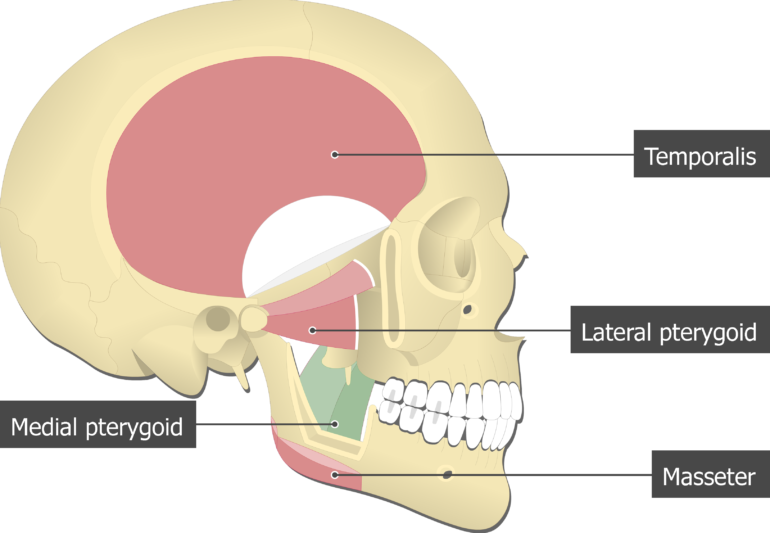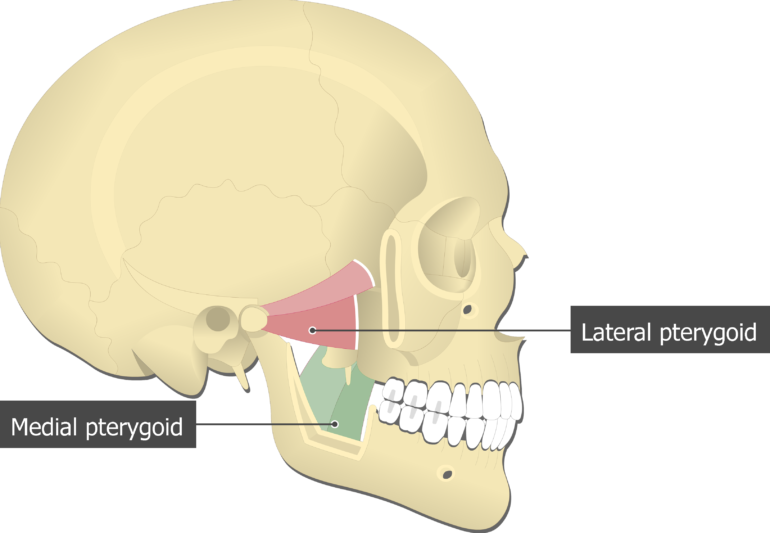The medial pterygoid acts together with masseter to elevate the mandible. Mandibular nerve via nerve to medial pterygoid.

Medial Pterygoid Muscle Attachments Actions Innervation
This muscle functions to move the lower jaw forward down and side.

. From medial surface of lateral pterygoid plate adjoining pro. By contracting on one side the medial pterygoid pushes the mandible to the opposite side. Levator palati and tensor palati muscles.
The medial pterygoid muscle functions to assist with elevation and protrusion of the mandible. The medial pterygoid muscle has functions including elevating the mandible closing the mouth protruding the mandible mastication especially for when the maxillary teeth and the mandibular teeth are close together and excursing the mandible contralateral excursion occurs with unilateral contraction. Muscles are responsible for locomotion and play an important part in performing vital body functions.
Where are the Pterygoids. The medial pterygoid muscle is one of the four paired muscles of mastication. The primary action is to elevate the mandible and laterally deviate it to the opposite side.
Superior constrictor of pharynx. Lateral Pterygoid The lateral pterygoid muscle is the primary muscle of the inferior temporal fossa. It has a second slip of origin.
The bilateral contraction of this muscle elevates the mandible and closes the mouth. Specifically the medial pterygoid muscle functions to. The medial pterygoid is innervated via a nerve towards medial pterygoid which is a division from the main trunk of the mandibular nerve.
Medial pterygoid is a thick quadrilateral muscle that connects the mandible with maxilla sphenoid and palatine bones. Acting together with the lateral pterygoid muscles they protrude the mandible which is important in the grinding movement of mastication. Muscle musl a bundle of long slender cells muscle fibers that have the power to contract and hence to produce movement.
The medial pterygoid muscle attaches to the angle of the mandible and to the lateral pterygoid plate to form a sling with the masseter muscle that suspends the mandible Figure 6-19. Medial pterygoid muscle consists of two heads. They move the mandible side to side.
Portable and easy to use Medial Pterygoid Muscle Action study sets help you review the information and examples you need to succeed in the time you have available. It is also known as internal pterygoid muscle. The primary action is to elevate the mandible and laterally deviate it to the opposite side.
Raiseelevate the lower jaw. It arises from the medial surface of the lateral pterygoid plate and the grooved surface of the pyramidal process of the palatine bone. The fibers of the medial pterygoid muscle run posterolaterally and insert to the medial surface of the mandibular ramus and angle.
The medial pterygoid muscle a major elevator of the jaw is a square-shaped masticatory muscle located on the medial aspect of the lower jaw bilaterally. The medial pterygoid muscle has a triple function. Since the medial pterygoid muscle attaches to the lower jaw the function of this muscle is to move the lower jaw.
First bilateral contraction of the muscle with lateral pterygoid muscle results in protrusion of the mandible1 This action results as the muscle fibers are aligned anteroposteriorly1. Use your time efficiently and maximize your retention of key facts and definitions with study sets created by other students studying Medial Pterygoid Muscle Action. Learn about the origin insertion functions and innervation of the medial pter.
This muscle lies medial to the lateral pterygoid muscle. Although having different origins both heads insert on the inner. Elevates mandible closes jaw helps lateral pterygoids in moving the jaw from side to side.
It also assists the lateral pterygoid muscle with side to side mandibular motion to help with the grinding of food. Specifically the medial pterygoid muscle functions to. They also protect the contents of the abdomen against injury and help support the body.
Learn the facial muscles easily with these quizzes and labeled diagrams. When after that you pronounce Me - you have to close your jaw first so the medial pterygoid muscle closes the mouth. The function of a muscle is usually associated with the part of the body to which the muscles attaches.
Acting together with the lateral pterygoid muscles they protrude the mandible which is important in the grinding movement of mastication. The medial pterygoid muscle attaches to the angle of the mandible and to the lateral pterygoid plate to form a sling with the masseter muscle that suspends the mandible Figure 6-19. Since the medial pterygoid muscle attaches to the lower jaw the function of this muscle is to move the lower jaw.
The medial pterygoid muscle is innervated by the medial pterygoid branch of the mandibular division of the trigeminal nerve CN V3. Raiseelevate the lower jaw. The lateral pterygoid muscle is a small thick muscle located on each side of the skull that assists with mastication chewing.
The medial pterygoid muscle has a triple function. It can assist in protrusion of the mandible. Styloglossus and stylopharyngeus.
From tuberosity of maxilla adjoining boneDeep head. Protract or protrude mandible. It belongs to the group of masticatory muscles along with the lateral pterygoid masseter and temporal muscles.
The function of a muscle is usually associated with the part of the body to which the muscles attaches. The arterial supply to medial pterygoid muscle is from the pterygoid branches of the maxillary artery. When you pronounce La - your jaw is now open so the lateral pterygoid muscle opens the mouth.
The pterygoid muscles are the two jaw. The medial pterygoid is a thick quadrilateral muscle. Actions of Medial Pterygoid Muscle on the mandible.
Second unilateral contraction of the medial pterygoid muscle with lateral pterygoid muscle ipsilaterally results in lateral movement of the. Specifically the medial pterygoid muscle functions to. It receives blood supply from the pterygoid branches of the maxillary artery.
This muscle also contributes to the elevation of the mandible acting as a synergist to the temporalis and masseter. Medial Pterygoid OriginSuperficial head. Since the medial pterygoid muscle attaches to the lower jaw the function of this muscle is to move the lower jaw.
Upon bilateral contractions the medial pterygoid muscles push the mandible forward protrude the mandible. See appendix 3-4 and see color plates. The medial pterygoid acts together with masseter to elevate the mandible.

Mnemonic Lateral Pterygoid Vs Medial Pterygoid Function Urdu Hindi Youtube
:background_color(FFFFFF):format(jpeg)/images/library/14110/Pterygoid_muscles.png)
Medial And Lateral Pterygoid Muscle Anatomy And Function Kenhub

Medial Pterygoid Muscle Wikipedia

The Muscular System Human Anatomy And Physiology Muscle Anatomy Muscular System
:background_color(FFFFFF):format(jpeg)/images/library/13050/4Q1NsvAE81JCSTJc7Tf0w_Pterygoideus_medialis_01.png)
Medial Pterygoid Origin Insertion Action Innervation Kenhub

Medial Pterygoid Muscle Attachments Actions Innervation

Medial Pterygoid Muscle Origin Insertion Function Nerve Supply Anatomy Kenhub Youtube

Figure Medial Pterygoid Muscle Image Courtesy O Chaigasame Statpearls Ncbi Bookshelf
0 comments
Post a Comment